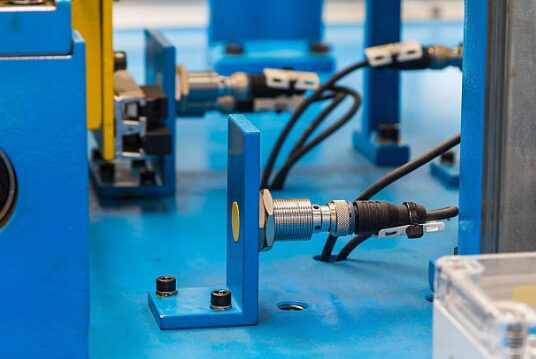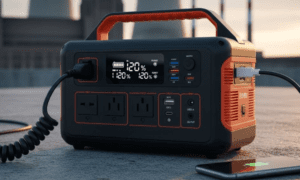Automatic machines and robotics make use of proximity sensors which are also used in highly accurate systems. These sensors detect objects without the need for physical contact which increases the effectiveness, reliability, and accuracy within the automated systems. Proximity sensors can instantly improve the automation involved in monitoring machinery movement, detecting components position, and controlling production progress. For a deeper understanding of how proximity sensors can enhance your systems, visit OMCH‘s proximity sensor solutions here https://www.omchsmps.com/ru/path/proximity-switch/. The article will guide you to know about proximity sensors.
What is a Proximity Sensor?
A proximity sensor identifies an object without making contact with it, typical range for such identification is preset. Proximity sensors are capable of detecting metal as well as plastic objects but it’s determined by the type of sensor in use. These sensors are widely used in industries where the center of interest is in non-contact sensing or in extreme environments that are hostile. Mechanical switches and other traditional sensors are not helpful here.
Proximity sensors function by emitting a field (electromagnetic, capacitive or optical) that interacts with nearby objects. In the case that an object is buzzing, the field is disrupted by an object which then leads the sensor to make an output signal. This output signal indicates if the object is near or isn’t near. These sensors are very effective and lightning fast. This assists with giving systems an efficient form of real time feedback.
Types of Proximity Sensors
Different proximity sensor types exist for different applications. The following are the most common proximity sensors:
Inductive Proximity Sensors
Inductive sensors detect the presence of metallic objects with the help of electromagnetic induction. Such sensors are most appropriate for the detection of metals, both ferrous and non-ferrous. These sensors find application in industrial automation for monitoring the location of machine elements and parts, movement of conveyor belts, and controlling robotic arms.
Capacitive Proximity Sensors
Capacitive proximity sensors can detect the presence of metals and non-metals alike. They mostly operate in regions where there is a change in capacitance when an object enters the electromagnetic field generated by the sensor. These sensors are used to detect non-metallic objects such as liquids, plastics, and wood.
Ultrasonic Proximity Sensors
Ultrasonic sensors can detect the presence of an object by using sound waves. These sensors emit high frequency sound waves and then measure the time it takes the sound to bounce back after it hits an object. Ultrasonic sensors find the widest application in distance measurement, level sensing, and object detection in industry including automotive, food processing, and packaging.
Photoelectric Proximity Sensors
Photoelectric proximity sensors detect the presence of objects usually using infrared light. We have photodetectors that can be Diffuse, Retro-reflective, or Through-beam. They allow for automation when transparent or reflective objects need to be sorted, inspected, packaged or handled.
Magnetic Proximity Sensors
Magnets are capable of being detected by these proximity sensors. From magnets, these sensors can find the presence of any moving or rotating objects. With such accuracy, they can be placed in vehicles, security networks, or systems for automation in industries.
Applications of Proximity Sensors
From automotive to robotics, which are both part of modern civilization, safety and automation systems use proximity sensors for myriad applications. Proximity sensors are crucial components in all aspects of industry automation as well as industrial needs. Here are some examples of the fields that use:
Automated Industrial Systems and Controls.
A factory with proper automation uses proximity sensors to monitor different tasks like speed monitoring, position detection, object counting, and even controlling movement parts on the assembly belt. This level of technology can enhance productivity, eliminate manual errors, and ensure timely automation. With efficient human- machine interface sensors, the system assures optimal performance for both human operators and machines.
Motion Control and Robotics
The use of proximity sensors in robotics, for enabling interaction with, and control over robots’ position and orientation, is great. It allows robotic arms to do any activity in a workspace such as packaging, assembly, and manipulation. Moreover, proximity sensors enhance robotic performance by collision avoidance and robot’s safety in an active work environment.
Motor Vehicle Industry
In the efforts of the automobile industry, systems that use proximity sensors have numerous advantages such as enhanced control and monitoring over a door locks, component position serving and supporting park assist functions.
Because of their capability to sense metal objects in a very precise setting, inductive and magnetic proximity sensors are useful for these applications.
Packaging and Handling of Materials
It is necessary to have proximity sensors in systems that involve handling, sorting, detection, and control of machinery within packaging and material handling. These sensors make it possible to guarantee that products are properly placed on conveyor belts, quality controlled, and processed. For the accurate filling of products, ultrasonic proximity sensors are frequently utilized for measuring levels and distances in tanks or containers.
Benefits of Proximity Sensors
Proximity sensors provide effective solutions, especially for industries where accuracy and dependability are very important. Here are the advantages of using proximity sensors in different settings:
Non Contact Detection
Unlike other sensors, proximity sensors are able to detect an object without physically touching them. This eliminates contact with the part being rotated in spite of wear and tear happening on the mechanical switches. Due to this non-contact feature, the lifespan of both the sensor and the object being detected, doing efficiently in environments with delicate materials and high-speed movements.
High Precision and Reliability
With proximity sensors, highly accurate and dependable detection is guaranteed which makes them vital in offering real time feedback. In an automated assembly line, when parts are positioned, monitored, or in robotic systems, the detected object’s proximity is measured, this is when proximity sensors are of use as they make sure accurate outcomes are given in every occasion.
Durability and Longevity
Even in extreme temperatures, rust, dampness, dust, humidity, vibrations and other severe conditions, these sensors will still be reliable, which assures their diagnosis in comparison to other sensors in more severe situations. This enhanced resistance in construction makes the proximity sensors suitable when used in industrial environments.
Compact Size and Easy Integration
Most systems can use proximity sensors due to their compact sizes and easy integration features. The sensors can be deployed in compact areas due to their small size. This is important in settings when equipment is housed in a more restricted environment.
Automation Simplifications and Maintenance Economies
Proximity sensors help in increasing efficiency and decreasing manual input by automating processes and providing timely data. This type of automation results in increased output, decreased errors, and reduced maintenance costs over time.
Conclusion
Proximity sensors are greatly used in modern industrial systems as non-contact detecting devices with fast response time and high reliability. These sensors are deployed in a number of applications like industrial automation, robotics, safety and security systems. Their ability to function in tough conditions while giving accurate and dependable performance makes them useful in enhancing operational productivity and minimizing maintenance costs.
For B2B companies looking for dependable sensors, OMCH offers powerful proximity sensors designed to meet the specific requirement of your business.

































